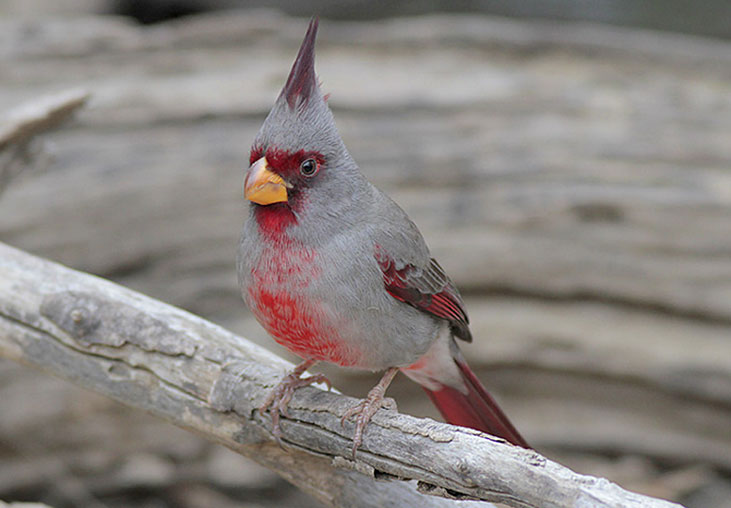The Pyrrhuloxia (Cardinalis sinuatus) is a lovely gray cardinal with a stubby yellow beak and red on its face, underparts, wings, tail, and wispy crest.
In areas with mesquite and other types of arid vegetation, pairs of Pyrrhuloxias call from the tops of bushes and pick seeds from the ground. Within their range, these pretty birds often visit backyards with water features, ground feeders, and fruiting cactus.
On this page
Identification
The Pyrrhuloxia is the same size and general shape as a Northern Cardinal. Like the more familiar cardinal species, this desert bird also has a longish, rounded tail, rounded wings, and prominent crest, and a conical beak.
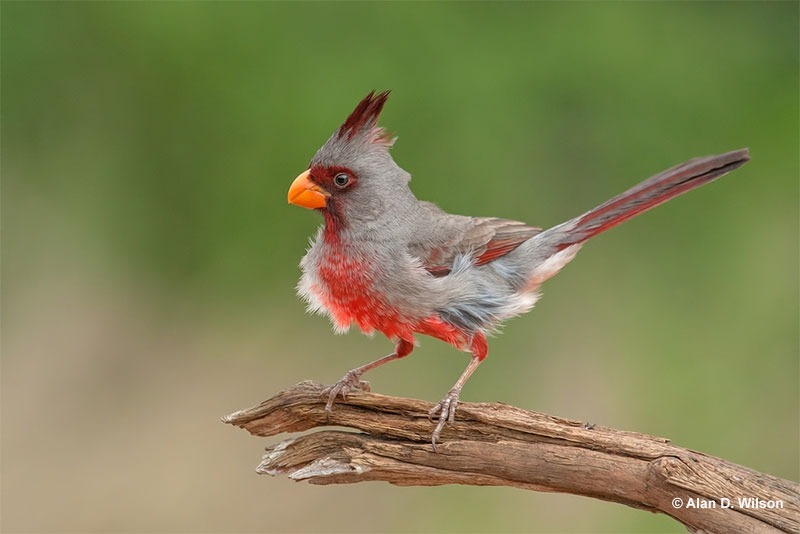
However, its crest is more slender and is only tipped with red, and its beak is more rounded and pale yellow. Male Pyrrhuloxias are mostly gray with rose-red around their eyes and on their throat. The red color extends in a thick line down its chest and onto its belly and undertail.
They also have some red on their wings and tail, and show red on their underwing.
Female and young Pyrrhuloxias look more or less like washed-out versions of the adult male with a grayish-yellow beak. They are pale gray-brown with tan and buff highlights on their belly and undertail, and only have red on their crest, wings, and tail.
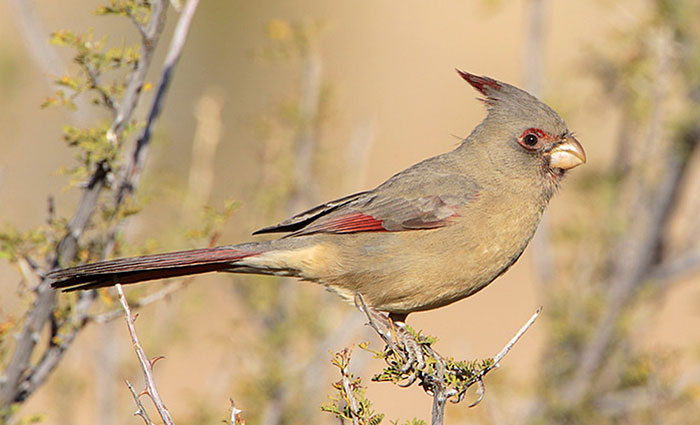
Female
In flight, sometimes, we can also see the pink color of their underwings.
On average, this species is 8.75 inches long, has a 12 inch wingspan, and weighs 1.3 ounces.
Males sing a variety of whistled songs that sound like, “cheer cheer cheer cheer cheer.” Females occasionally sing, but they aren’t as loud. Both sexes also make a sharp “chip” call.
Food
Pyrrhuloxias feed on a variety of bugs, including beetles, caterpillars, grasshoppers, cicadas, and other big insects. They also eat seeds from Pigweed, Sorghum, various grasses, and many other plants.
When this bird visits backyards, it likes to feed on fruiting cactus, can also eat berries, and visits ground feeders for peanut butter suet, and seeds that are scattered on the ground.
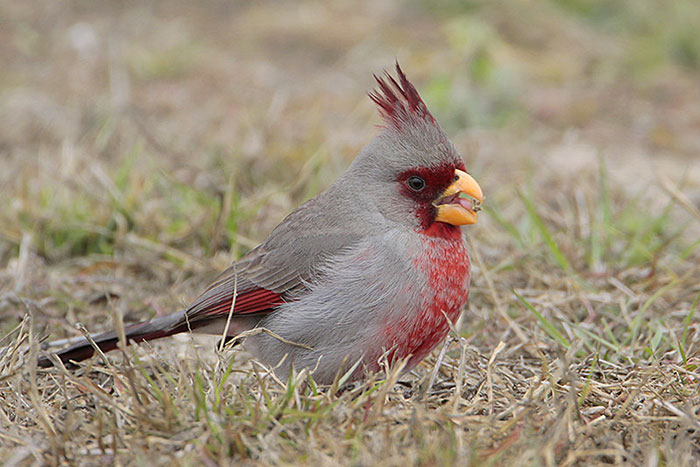
Photograph © Greg Lavaty
In spring and summer, pairs of these pretty birds forage by hopping on the ground in vegetated spots, and picking up whatever insects and seeds they find. They also move up into low, thick vegetation to pick food items from leaves and bark.
Occasionally, this cardinal species can also sally into the air to catch a bug, and they like to drink nectar from cactus flowers. In fall and winter, Pyrrhuloxias form flocks that forage for seeds in the same habitats as summer but they also frequent more open areas, especially spots with mowed grass.
When they find a locally abundant food source, several members of this species can focus on that particular food source until they eat most of it. In such situations, Pyrrhuloxias can ignore other food items they would normally quickly catch and eat.
Nesting and Eggs
From late February to April, Pyrrhuloxias establish nesting territories and the female picks a place to build her nest. She usually chooses a spot five to fifteen feet above the ground in a hedgerow or other dense, brushy vegetation.
The female builds her cup nest well away from the main trunk, often on flimsy twigs, and without any help from the male. The female Pyrrhuloxia constructs it with bark strips, grass, rootlets, and other plant matter and lines it with spiderwebs, feathers, and other soft materials.
Once the nest is ready, she lays two to four pale green eggs with some pale gray and dark brown markings.
They are one inch long, and the mother bird incubates them for two weeks. After hatching, both parents feed the nestlings insects and occasional cactus fruits. When feeding their young, they perch on a twig next to the nest and reach in to give food to the babies.
The young birds leave the nest ten to thirteen days later but continue to be fed by their parents for at least two more weeks.
After becoming independent from their parents, fledglings flock with other young birds that wander around nearby habitat. In fall, they join flocks of adult Pyrrhuloxias.
Current Situation
Pyrrhuloxias live in arid brushy places and streamside habitats. They can also frequent hedgerows in farmlands and prefer more upland deserts than the hot, open lowland deserts of southwestern Arizona.
We find them in other parts of Arizona and in New Mexico east to central and southern Texas. Much of this bird’s range is also found in the northern half of Mexico.
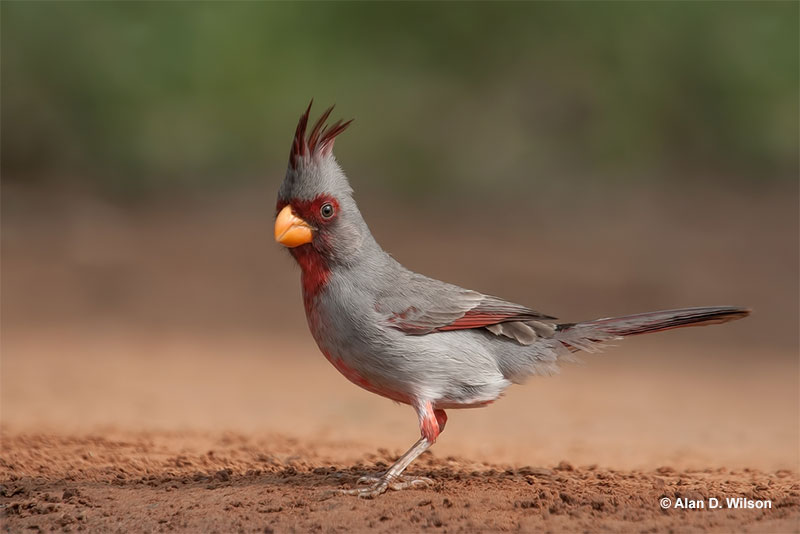
This species is listed as Least Concernin the IUCN Red List.
The Pyrrhuloxia is a common bird and not considered to be threatened. However, since the 1960s, its numbers have dropped by more than 50%.
This decrease is thought to be associated with clearing huge amounts of arid brush for housing and farmland in Arizona and other parts of its range.
Fortunately, it lives in several protected areas and, as long as some habitat is present, is an adaptable bird that can occur on farms and in some urban areas.
Facts
- This bird’s odd name is related to its coloration and the shape of its beak. “Pyrrhula” is a term that means “fire” or “flame” and refers to the red in its plumage. The “loxia” part of its name means “crooked” and refers to its oddly-shaped beak.
- Many bird species flock during the winter, including the Pyrrhuloxia. This species can form big groups of 1,000 birds! Although people usually encounter much smaller groups at their backyard feeders, birding in wilder areas can turn up large groups of this beautiful bird.
- Pyrrhuloxias occasionally visit water features but, often, more for bathing than a drink. Like many other desert birds, they get most or all of the liquid they need from the insects and fruits that they feed on.
- Although the Northern Cardinal tends to prefer dense and wetter areas than the Pyrrhuloxia, in some places, they occur together. In those areas, their songs can sound very similar, and the birds occasionally form hybrid pairs.
Similar Species
The Pyrrhuloxia is a distinctive bird but can look like one or two other species. Fortunately, with a good look, we can usually recognize it.
Northern Cardinal
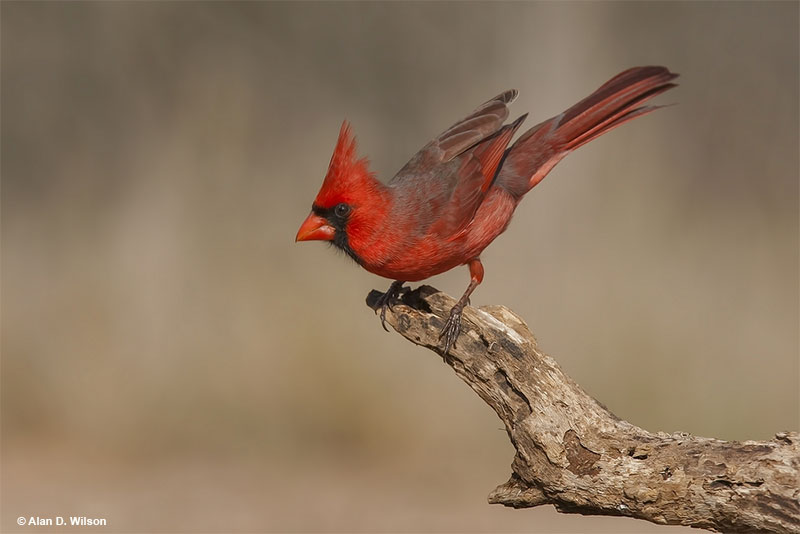
This closely related Northern Cardinal has a similar crested shape and size, but the Pyrrhuloxia is never as red as a male Northern Cardinal, doesn’t have so much black on its face, and has a yellowish beak.
Female Northern Cardinals look most like a female Pyrrhuloxia but they can be easily separated by their bill color; orange-red for the Northern Cardinal, and yellowish for the Pyrrhuloxia.
Abert’s Towhee
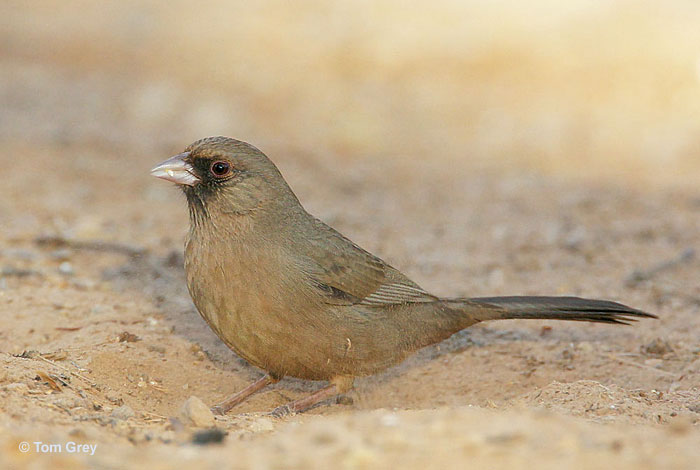
The Abert’s Towhee is similar in size and can live with the Pyrrhuloxia in some parts of Arizona. With its pale, conical beak, gray-brown coloration, and some black on its face, the Abert’s Towhee can look a bit like a female Pyrrhuloxia. However, it never has red in its plumage, lacks a crest, and a has a contrasting red-brown undertail.
Frequently Asked Questions
Is a Pyrrhuloxia a cardinal?
Yes, Pyrrhuloxia is a type of cardinal. Although it is a different species than the Northern Cardinal, it is related to that familiar bird.
Where are Pyrrhuloxias found?
Pyrrhuloxias are found in brushy arid habitats in Arizona, New Mexico, central and southern Texas, and Mexico.
What is the common name for Pyrrhuloxia?
The common name for Pyrrhuloxia is “Desert Cardinal”.
How do you say Pyrrhuloxia?
You say “Pyrrhuloxia” like “peer-uh-lok-see-uh.”
What does a Pyrrhuloxia bird look like?
A Pyrrhuloxia bird looks like a gray cardinal with a stubby, yellow beak and red on its face, throat, and as a thick line that goes down its chest and belly. It also has a red tip on its wispy crest, and red on its wings and tail.

